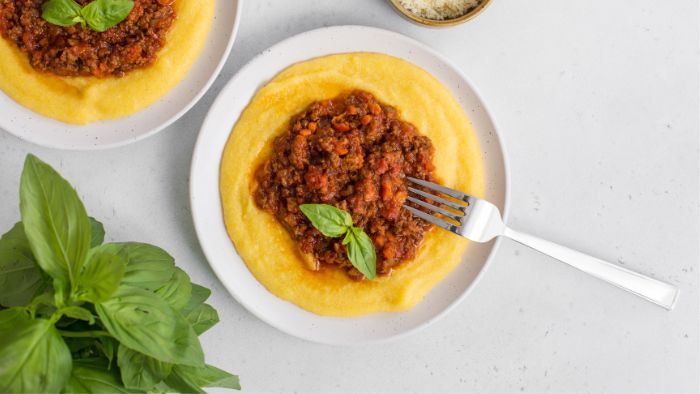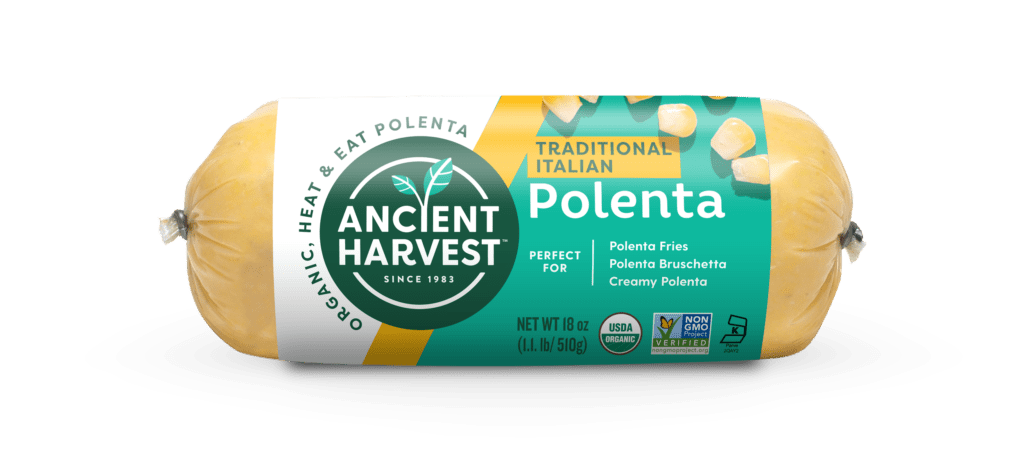Last Updated on June 27, 2022
Today, we’re going to be answering the question, polenta – is it gluten free? If the gluten-free way of life is new to you, it can be quite tricky to navigate. And as polenta is a grain-based dish, you may be wondering if it’s suitable to consume when following a gluten-free diet. We’ve got you covered! From what polenta actually is, to brands of gluten-free polenta – let’s take a closer look.
What Is Polenta?
You’ll likely already know what polenta is, but if you’re unfamiliar, polenta is a dish that traditionally comes from Italy. It’s essentially cornmeal that has been boiled. If you’re serving it hot, as it comes, it makes for a great porridge to start off your day. However, if you leave it to go hard, you can do almost anything with it! You can fry it, grill it, bake it – and it’s absolutely delicious.

Learn more about: Is Hominy Gluten-Free?
Ingredients In Polenta
If you’re wondering which ingredients you’ll find in polenta…there really aren’t too many! The ingredients are:
- cornmeal (either yellow or white)
- liquid (water or stock)
That really is it!
Nutritional Information Of Polenta
Once cooked in water, each 3/4 cup of polenta contains the following nutritional value:
- Calories: 80
- Fat: <1g
- Fiber: 1g
- Protein: 2g
- Carbs: 17g
Is Polenta Gluten Free?
As the main ingredient in polenta is corn, traditional polenta is typically gluten-free. However, because of risks such as cross-contact (i.e being made in an area where gluten is handled) when it comes to grains, I would highly recommend choosing a polenta that carries a gluten-free label. If you’re looking for such brands, we’ll be taking a look at the most popular in this post!
Is Polenta Dairy Free?
Typically, the polenta should be dairy-free as it’s usually made using water and cornmeal (both of which are safe). However, some polenta is made using milk, and some people like to add butter or cheese products. Because of this, it’s always best to check any ingredients labels or check with your server if you’re eating out.
What’s The Difference Between Polenta and Cornmeal?
There really isn’t much difference when it comes to polenta and cornmeal. As we know, they’re both made using corn! However, there is one main difference: the consistency. Polenta is not as mushy as cornmeal – but it is just as delicious!
Gluten Free Polenta Brands
If you’re looking for brands that carry a gluten-free label, look no further. While there are several brands that offer gluten-free polenta, these are my go-to picks.
Ancient Harvest
Ancient Harvest is a great brand that offers a huge selection of gluten-free goodness. Their traditional polenta is not just gluten-free, but also organic and non-GMO. This particular product is perfect for making dishes such as polenta fries.
The ingredients in this product are:
- water
- organic yellow corn meal
- salt
- tartaric acid
- vitamin c
- vitamin a

Bob’s Red Mill
Another popular brand is Bob’s Red Mill. Bob’s Red Mill offers certified gluten-free products, with their Gluten Free Corn Grits/Polenta being one of them. It’s also certified vegan too! This particular product is as natural as they come. The only ingredient you’ll find in this polenta is corn. You can pick it up for around $4 a bag. Find out more about this polenta here.
Gluten Free Creamy Polenta Recipe
If you’re looking to make the creamiest, tastiest polenta – we’ve got just the recipe for you. This recipe is inspired by a recipe from Rachael Roehmholdt. What I love about this recipe is that it’s not just super quick, but super easy too!
Ingredients
The ingredients you’ll need for this recipe are:
- 4 cups of liquid (you can choose water, stock, milk, etc.)
- 1 cup of polenta (it may be called coarse cornmeal)
- 1/2 teaspoon of salt (to taste)
- 1 tablespoon of butter or oil (optional)
Recipe
Now all you need to do is:
Step 1: Boil
Using a pan or pot, heat your liquid over high heat until it reaches a boil. This is the same whether you’re using water, stock, milk, etc. Once boiling, gradually adds the cornmeal. Keep stirring slowly until you reach a smooth consistency. Once smooth, reduce the wheat and stir vigorously continually. Your polenta should start to get thicker, and this will take around 5 minutes. (It’s important to stay by the pot at this point, as the polenta can be quite temperamental!).
Step 2: Flavor
Once thickened, add the salt to taste. And at this point, you can also add the butter if you choose to use it. I would highly recommend it as this really enhances the flavor and makes it extra creamy.
Step 3: Serve
You can serve the polenta as it is. Or add herbs if it’s a side dish. Or fruit if a breakfast dish. Enjoy!
Read more about Cornmeal Substitute For Cornbread
Conclusion
I hope this article has helped you to answer the question, polenta – is it gluten-free? The answer is – most of the time. The most important thing to remember is to check ingredients labels and always opt for products that carry a gluten-free label, if possible.
Do you know of any tips or tricks when it comes to making polenta? If so, please feel free to let me know in the comments below. Sharing is caring!
FAQs
Does Polenta Have Gluten or Dairy?
It's very unusual for polenta to contain gluten. However, it can sometimes contain dairy depending on how it's made. If making at home, it's easy to make dairy free.
How Do I Make Polenta Dairy Free?
For dairy free polenta, just be sure to use water or stock as your liquid choice, instead of milk. And also omit any butter, or use a dairy free alternative.
Is Polenta Vegan Friendly?
If made with water, instead of milk - yes, polenta should be safe to consume when following a vegan diet.
Is Polenta Whole Food Plant Based?
Yes! As polenta is just corn, it's considered safe to eat on a plant based diet.

Hi, my name’s Zoë. I’m 28 years old and live in London, UK. I work full time as a freelance writer and critic for West End theatre. Writing has been a passion of mine for as long as I can remember. I spend most of my free time at the theatre, or at conventions. I’m married to the love of my life, and live in a small apartment with my fur baby, Lillie. I run two of my own blogs: No Safer Place and Stage to Page: both of which have won awards. I also have a YouTube channel where I talk about all things stagey.

